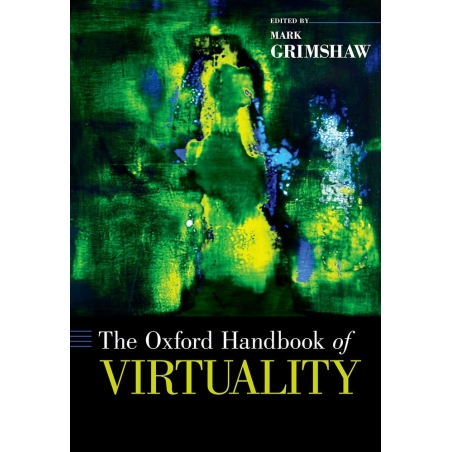The book is a compendium of thinking on virtuality and its relationship to reality from the perspective of a variety of philosophical and applied fields of study. Topics covered include presence, immersion, emotion, ethics, utopias and dystopias, image, sound, literature, AI, law, economics, medical and military applications, religion, and sex.
CONTENTS
Mark Grimshaw: Introduction
I. The Foundations of Virtuality
1. Bruce Damer & Randy Hinrichs: The virtuality and reality of avatar cyberspace
2. Philip Brey: The physical and social reality of virtual worlds
3. Brian Massumi: Envisioning the virtual
4. Andre Nusselder: Being more than yourself: Virtuality and human spirit
5. Maria Beatrice Bittarello: Mythologies of virtuality: 'Other space' and 'shared dimension' from ancient myths to cyberspace
6. Michael R. Heim: The paradox of virtuality
II. Psychology & Perception
7. James K. Scarborough & Jeremy N. Bailenson: Avatar psychology
8. Elizabeth J. Carter & Frank E. Pollick: Not quite human: What virtual characters have taught us about person perception
9. Jean-Claude Martin: Emotions and altered states of awareness: The virtuality of reality and the reality of virtuality
10. Angela Tinwell: Applying psychological plausibility to the Uncanny Valley phenomenon
11. Deborah Abdel Nabi & John P. Charlton: The psychology of addiction to virtual environments: The allure of the virtual self
12. Giuseppe Riva & John A. Waterworth: Being present in a virtual world
13. Gordon Calleja: Immersion in virtual worlds
III. Culture & Society
14. Paul C. Adams: Communication in virtual worlds
15. David Rudd: So good, they named it twice? A Lacanian perspective on Virtual Reality from literature and the other arts
16. Erik Champion: History and cultural heritage in virtual environments
17. Julie M. Albright & Eddie Simmens: Flirting, cheating, dating, and mating in a virtual world
18. Stale Stenslie: Cybersex
19. Robert M. Geraci: A virtual assembly: Constructing religion out of zeros and ones
20. William Cheng: Acoustemologies of the closet
IV. Sound
21. Karen Collins: Breaking the fourth wall? User-generated sonic content in virtual worlds
22. Tom A. Garner & Mark Grimshaw: Sonic virtuality: Understanding audio in a virtual world
23. Trevor S. Harvey: Virtual worlds: An ethnomusicological perspective
24. Martin Knakkergaard: The music that's not there
V. Image
25. Gary Zabel: Through the looking glass: Philosophical reflections on the art of virtual worlds
26. Anthony Steed: Recreating visual reality in virtuality
27. Patrick Lichty: The translation of art in virtual worlds
28. Simon J. Harris: Painting, the virtual and the celluloid frame
VI. Economy & Law
29. Greg Lastowka: Virtual law
30. Vili Lehdonvirta: Virtuality in the sphere of economics
VII. A-Life & Artificial Intelligence
31. Phil Carlisle: On the role of digital actors in entertainment-based virtual worlds
32. Tim Taylor: Evolution in virtual worlds
33. David G. Green & Tom Chandler: Virtual ecologies and environments
34. Gabriel Robles-De-La-Torre: Computational modeling of brain function and the human haptic system at the neural spike level: Learning the dynamics of a simulated body
VIII. Technology & Applications
35. John A. Waterworth & Eva L. Waterworth: Distributed embodiment: Real presence in virtual bodies
36. Alan Chalmers: Level of realism: Feel, smell and taste in virtual environments
37. Mark Billinghurst, Huidong Bai, Gun Lee, Robert Lindeman: Developing handheld augmented reality interfaces
38. Keysha I. Gamor: Avoidable pitfalls in virtual world learning design
39. Giuseppe Riva: Medical clinical uses of virtual worlds
40. Roger Smith: Military simulations using virtual worlds
IX. Utopia & Dystopia
41. Charles M. Ess: Ethics at the boundaries of the virtual
42. Patrice Flichy: The social imaginary of virtual worlds
43. David Kreps: Virtuality and humanity
44. Andrea Hunter & Vincent Mosco: Virtual Dystopia
Tom Boellstorff: An afterword in Four Binarisms
Index




